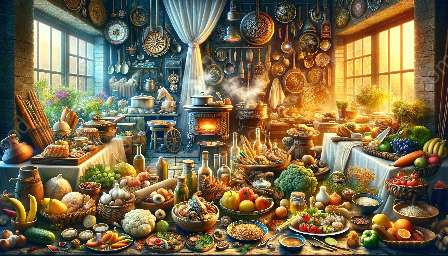Food preservation methods are essential to the art and science of gastronomy and play a crucial role in the field of food and drink. They not only help extend the shelf life of food but also contribute to the diversity and richness of culinary traditions. In this comprehensive guide, we will delve into various food preservation techniques, including canning, pickling, drying, and more, to showcase how these methods enhance and contribute to the world of gastronomy.
The Art and Science of Food Preservation
Food preservation encompasses a wide range of techniques that have been developed over centuries to ensure the availability of food beyond its harvest period. The methods of food preservation have evolved from simple techniques used by ancient societies to sophisticated modern processes that help maintain the flavor, texture, and nutritional value of food.
Canning: Preserving through Heat
Canning is one of the most popular methods of food preservation, especially for fruits and vegetables. The process involves sealing food in airtight containers and heating them to destroy microorganisms that could cause spoilage. This method allows for long-term storage of foods like jams, jellies, and pickles, while preserving their flavors and nutrients.
The Science Behind Canning
When food is heated during the canning process, the heat destroys enzymes and microorganisms, preventing fermentation and decay. The sealed containers then keep out air and microorganisms, ensuring the long-term preservation of the food inside.
The Art of Flavor Preservation
One of the remarkable aspects of canning is its ability to preserve the natural flavors of food. Whether it’s the sweetness of peaches or the tanginess of pickles, canning locks in the flavors, allowing people to enjoy their favorite produce all year round.
Pickling: Enhancing Flavor through Fermentation
Pickling is a preservation method that has been practiced for thousands of years and has gained popularity worldwide. The process involves submerging food in a liquid brine or vinegar solution, which creates an acidic environment that inhibits the growth of bacteria and preserves the food.
The Science of Pickling
The preservation process of pickling relies on the conversion of sugars into lactic acid by naturally occurring bacteria, creating an environment that is unfavorable for spoilage organisms. This transformation enhances the flavor of the food and gives pickled items their characteristic tanginess.
The Art of Culinary Transformation
From crunchy cucumbers to spicy kimchi, pickling not only extends the shelf life of vegetables but also transforms their flavors, creating unique and appetizing culinary experiences. This ancient preservation method has become an integral part of gastronomy, adding depth and complexity to various cuisines.
Drying: Preserving Naturally through Dehydration
Drying, or dehydration, is a method of food preservation that involves removing moisture from food products, such as fruits, meats, and herbs. By reducing the water content, the growth of spoilage microorganisms is inhibited, allowing for long-term storage of the dried food.
The Science of Dehydration
Dehydration inhibits the growth of bacteria, yeasts, and molds by removing the water they need to thrive. This method also concentrates the flavors and nutrients in the food, resulting in intense and robust flavors when the dried items are rehydrated for consumption.
The Art of Culinary Innovation
From chewy dried fruits to flavorful jerky, drying preserves the essence of food items while transforming their textures and intensifying their flavors. It is a versatile preservation method that has been utilized across cultures to create a wide array of culinary delights.
Exploring Modern Preservation Techniques
While canning, pickling, and drying are traditional methods of food preservation, modern techniques, such as vacuum sealing, freeze-drying, and irradiation, have expanded the possibilities for extending the shelf life of various food products. These innovative methods have revolutionized the preservation and storage of food, leading to new gastronomic experiences and culinary creations.
The Role of Food Preservation in Gastronomy
Food preservation methods not only ensure food security and reduce food waste but also contribute to the richness and diversity of culinary traditions. They enable the availability and enjoyment of seasonal produce throughout the year and play a vital role in the preservation of cultural food heritage.
Preservation as an Essential Gastronomic Element
Preservation methods have allowed culinary traditions to flourish by making it possible to enjoy regional and seasonal delicacies beyond their natural availability. They have become an integral part of gastronomy, inspiring chefs and home cooks to experiment with preserved ingredients and create innovative dishes.
Promoting Sustainable Gastronomy
By reducing food waste and supporting sustainable practices, food preservation methods align with the principles of sustainable gastronomy. They enable the utilization of surplus produce and support local economies while fostering a deeper connection to the origins of food.
Conclusion
Food preservation methods, from traditional practices to modern innovations, have significantly contributed to the evolution of gastronomy and the culinary arts. They have not only extended the availability and diversity of food but also enhanced the flavor, texture, and cultural significance of culinary creations. Embracing and understanding food preservation is essential for aspiring gastronomes and food enthusiasts, as it provides a deeper insight into the culinary traditions and the sustainable utilization of food resources.

